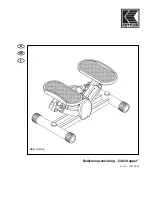
12. General Information
68
■
Power supply:
120 V AC, 60 Hz
■
Fax memory capacity
*3
:
Transmission: Approx. 25 pages
Reception: Approx. 28 pages
(Based on the ITU-T No. 1 Test Chart in standard
resolution.)
■
Voice memory capacity
*4
:
Approx. 18 minutes of recording time including greeting
messages
*1 Transmission speed depends on the contents of the
pages, resolution, telephone line conditions and
capability of the other party’s machine.
*2 Transmission speed is based on the ITU-T No. 1 Test
Chart with original mode. If the capability of the other
party’s machine is inferior to your unit, the
transmission time may be longer.
*3 If an error occurs during fax reception, such as a
paper jam or if the recording paper runs out, the fax
and subsequent faxes will be retained in memory.
*4 Recording time may be reduced by the calling party’s
background noise.
Note:
L
The accuracy of the clock is approximately
±
60
seconds a month.
ITU-T No. 1 Test Chart
Note:
L
Design and specifications are subject to change
without notice.
L
The pictures and illustrations in these instructions
may vary slightly from the actual product.
Recording paper specifications
Recording paper size:
Letter: 216 mm
×
279 mm (8
1
/
2
"
×
11")
A4: 210 mm
×
297 mm (8
1
/
4
"
×
11
11
/
16
")
Recording paper weight:
60 g/m
2
to 90 g/m
2
(16 lb. to 24 lb.)
Note for recording paper:
L
Do not use the following types of paper:
–
Paper with cotton and/or fiber content that is over
20 %, such as letterhead paper or paper used for
resumes
–
Extremely smooth or shiny paper, or paper that is
highly textured
–
Coated, damaged or wrinkled paper
–
Paper with foreign objects attached, such as tabs
or staples
–
Paper which has dust, lint or oil stains
–
Paper that will melt, vaporize, discolor, scorch or
emit dangerous fumes near 200
°
C (392
°
F),
such as vellum paper. These materials may
transfer onto the fusing roller and cause damage.
–
Moist paper
L
Some paper only accepts print on one side. Try using
the other side of the paper if you are not happy with
the print quality or if misfeeding occurs.
L
For proper paper feeding and best print quality, we
recommend using long-grained paper.
L
Do not use paper of different types or thickness at the
same time. This may cause paper jams.
L
Avoid double-sided printing.
L
Do not use paper printed from this unit for double-
sided printing with other copiers or printers. This may
cause paper jams.
L
To avoid curling, do not open paper packs until you
are ready to use the paper. Store unused paper in
the original packaging, in a cool and dry location.
12.2.2 Cordless handset
■
Operating environment:
5
°
C – 40
°
C (41
°
F – 104
°
F)
■
Frequency:
2.4 GHz – 2.48 GHz
■
RF (Radio Frequency) power output level:
0.04 W – 0.1 W
■
Dimensions:
Approx. height 167 mm
×
width 48 mm
×
depth 31 mm
(6
9
/
16
"
×
1
7
/
8
"
×
1
1
/
4
")
■
Mass (Weight):
Approx. 107 g (0.24 lb.)
■
Power supply:
Ni-MH battery (2.4 V, 830 mAh)
■
Security codes:
520,000









































